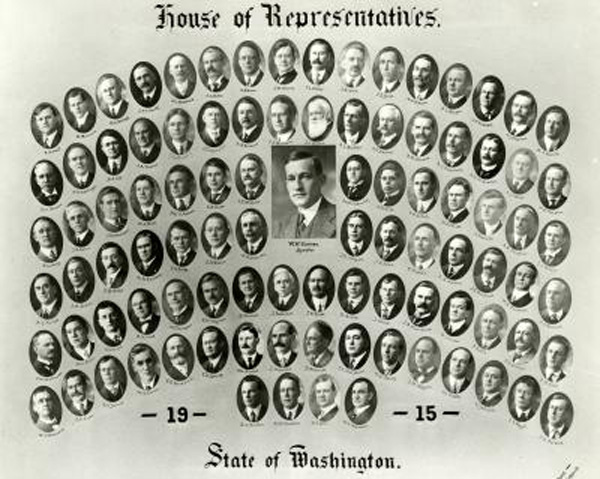How WA Legislature looked a century ago
Members of the 1915 House of Representatives. (Image courtesy State Digital Archives)
Political junkies and Olympia-watchers know plenty about today’s Washington Legislature, its key players, accomplishments and points of disagreement.
What was our state Legislature like a century ago? What kind of people served as legislators? What were their backgrounds? What bills did they pass?
The State Library has a book that answers these and other questions. It’s called “The Fourteenth Session: A Brief History of the Men who represented the Million and a Half People of the State of Washington in the Legislature in 1915.”
Some interesting factoids from the 310-page book was written by Alfred T. Renfro:
• The House was comprised of 78 Republicans, 13 Democrats and six Progressives. The Senate had 32 Republicans, six Democrats and four Progressives.
• The average age of a senator was 47.6; in the House, 44. The oldest state representative was 70; the youngest, 26. In the Senate, the oldest member was 63.
• All of the legislators were men. (The 1913 House included the first two women ever elected to the Washington Legislature, Frances Axtell and Nena Croake.)
• The House had nine native-born Washingtonians, while the Senate had only one. Fourteen legislators came from Iowa, 12 from Wisconsin, 11 from Illinois and 10 from Michigan. Eight were born in Canada, four in England and one in Scotland.
• Thirty professions and occupations were represented, including attorneys, doctors, farmers, merchants, teachers, publishers, real estate men, lumbermen, bankers, insurance agents and even an undertaker.
• There was a limitation of bills. Among the reasons, according to the book: “Care was taken that there should be no conflicting measures or several bills of similar nature having the same subject and purpose in view. This resulted in stronger bills, fewer and better considered laws.” While the 1913 session saw 655 bills introduced in the House and 466 in the Senate, there were only 276 bills introduced in the House and 408 in the Senate in 1915.
• According to the book, “Open hearings were one of the features of the session. Many long evenings were spent by the committees hearing the different sides of questions, then before them. This encouraged confidence and placed lobbying out in the bright light and above board.”
